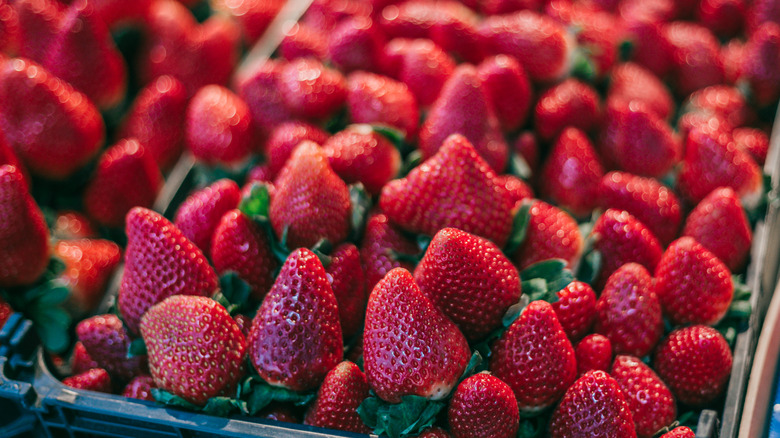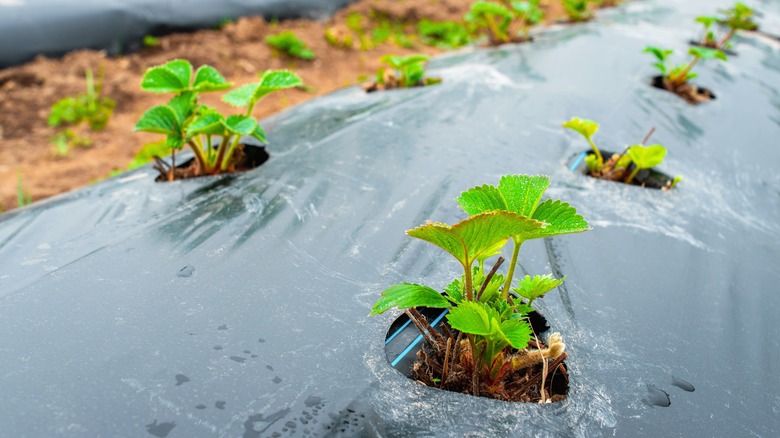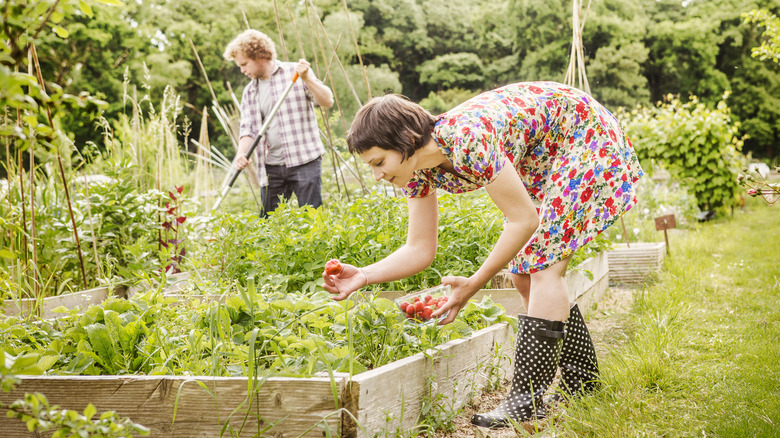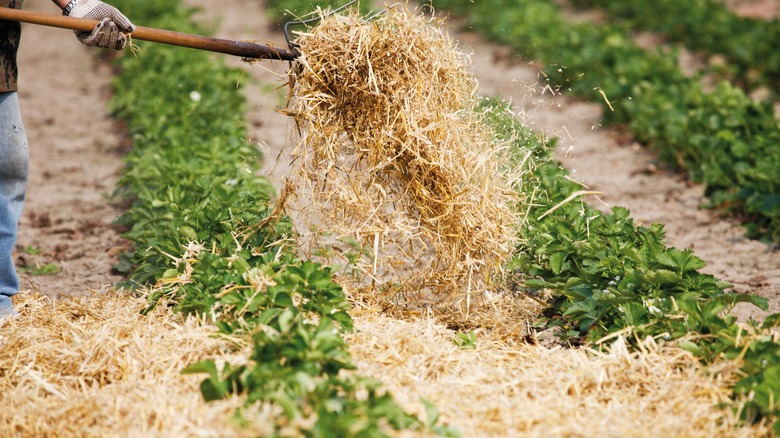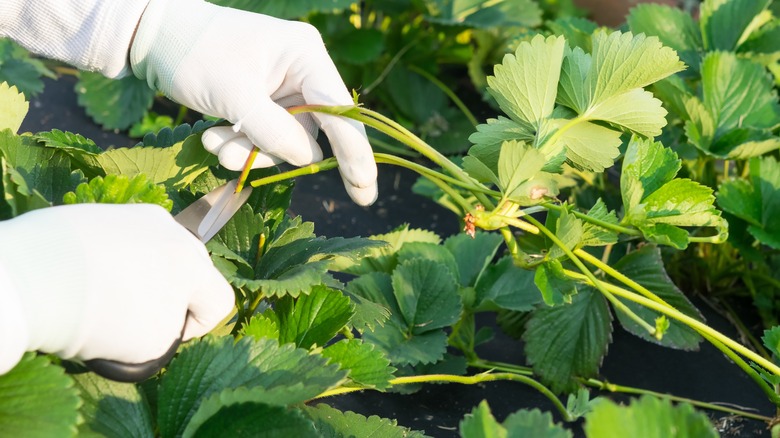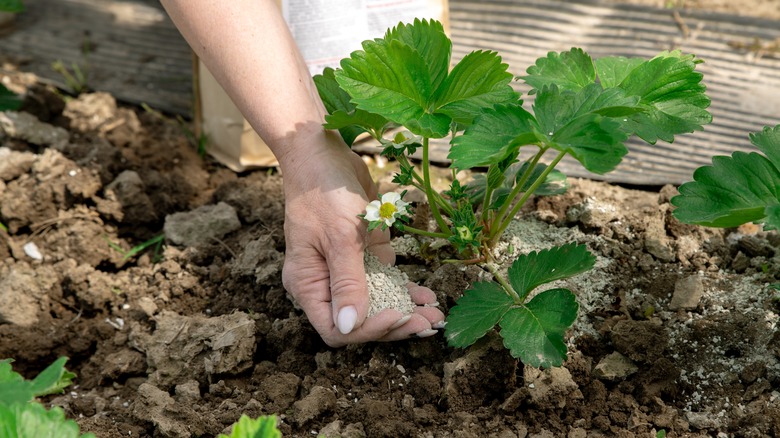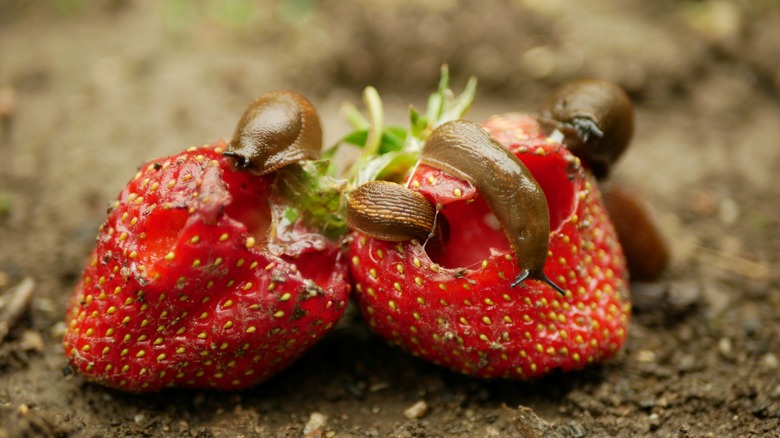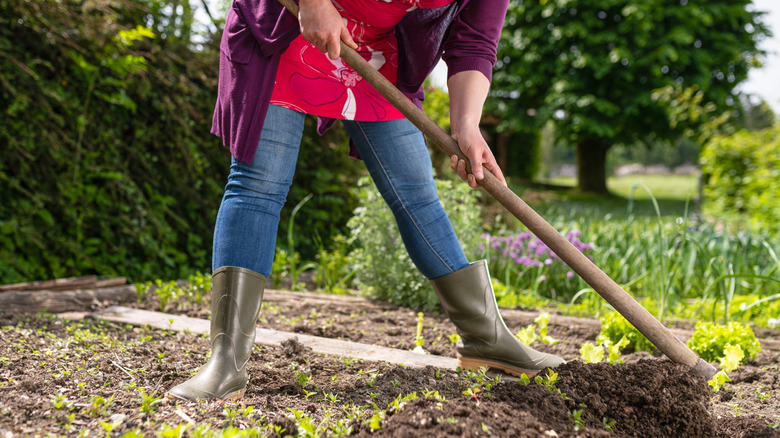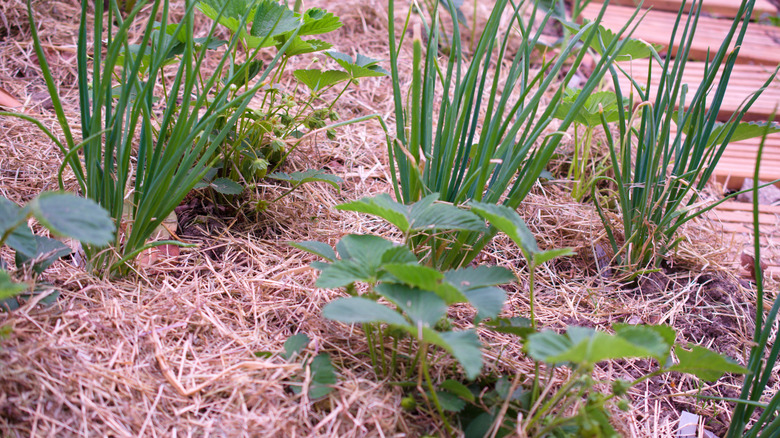13 Tips And Tricks For Growing The Tastiest Strawberries On The Block
Among all the fruits in the world, strawberries have to be some the most popular. What would summertime be without strawberries? Their fresh, sweet flavor is rivaled by none. But while eating strawberries is one thing, growing them successfully is another matter. A good strawberry crop is something many gardeners aspire to but seldom achieve. You need to know some gardening basics before you put seeds in the ground; otherwise, you are going to have a really hard time getting strawberries to grow. A lot depends on your climate, the type of strawberry you choose, and how healthy your soil is.
Fortunately, there is a lot you can do to remedy any potential pitfalls, like the mistakes beginning gardeners make way too often. We're going to go over exactly how you can grow a successful strawberry crop in your own yard. With some luck and patience, these strawberry-growing tips and tricks will have you producing the tastiest strawberries on the block!
Variety is everything
If you don't choose the right variety of strawberries for your unique growing region, you will not be able to reap the best harvest. Variety is everything when it comes to strawberries. This is true with any other fruit or vegetable, but strawberries are especially sensitive to climate zones. You need to be aware of your specific USDA hardiness zone to grow the best strawberries (it's a map detailing the types of growing areas found around the United States).
These plants come in three different categories: June-bearing strawberries, which grow and ripen in early June; everbearing strawberries, which have two yearly crops in spring and fall, and day-neutral strawberries, which are cold and shade tolerant but less sweet. June bearing is the most commonly grown in the USA, with varieties like Allstar, Cabot, and Honeoye being some of the most popular and flavorful.
A little bit of research will indicate which berries will grow best in which environments. If you are in colder climates with more cloud cover, a day-neutral variety like Albion will work perfectly. Growers in warmer climates would do well with June or everbearing varieties, though they still need to make sure that the strawberry can grow in their zone before buying seeds. If it can't grow in the climate, search for a variety that can.
Spacing is the key to neat rows
Efficient crop spacing depends on the availability of backyard space. According to Today's Homeowner, the national average size of a backyard lies around 23,000 square miles or just shy of half an acre. If you dedicate your entire yard to strawberries, you're going to have a lot of fruit. However, most people prefer a diverse garden landscape and will include strawberries as part of that. So, if you have decent room and want to grow a lot of strawberries, here are some spacing rules to go by.
As strawberries grow in vines, they can become a tangled mess if you are not careful. Spacing offers a partial solution to this. Strawberries sown 18 to 24 inches apart in rows separated by 4 feet are going to give you the best chance at a neat strawberry patch.
This may seem like a lot of space, and it is if you are planning on planting a lot of strawberries. However, if you have two rows with 5 strawberry plants in each row, that's 40 square feet for 10 plants. That's not a ton of space, considering the size of the yard. If you don't want to plant in the ground, you can negate the need for rows by planting in containers. However, you might not get as much crop yield as planting in the ground.
Location, location, location
As they say in real estate, the key to a successful sale is "Location, location, location!" The same is true of a successful strawberry plant. While there are certain plants that will survive, or indeed thrive, in the shade, strawberries are not universally among them. Day-neutral varieties will grow in colder, shadier conditions but will lose flavor and size. Most strawberries, especially June-bearing varieties, need a lot of sunlight in order to grow at their best.
At a minimum, most strawberries require 6 hours of direct sunlight in order to thrive. If they can get 8 hours, even better. Like many plants, strawberries feed off of the sun's rays and, through photosynthesis, grow as they receive more feed. As such, the more sunlight you can provide your strawberry plants, the better they will grow.
Now, if you have berries in containers, it is very easy to find a spot on your deck, patio, or yard that gets a ton of sunshine throughout the day. However, if you're directly sowing your berries, you need to locate a spot in your yard that is free of sun-blocking obstructions like trees or tall hedges. This is the place to plant your strawberries and any other sun-loving plant you wish to cultivate in your yard.
Frequent watering yields juicy berries
Watering is important to the success of any garden, but you need to walk a fine line when doing it, especially with strawberries. There is a balance that needs to be struck. Too dry, and your berries will die. The major mistakes you need to avoid when watering your garden include overwatering, as it causes plants to develop fungus and root rot. Neither scenario is what you want.
While you can't do anything about the weather, you can do something about your own watering tactics. A good rule of thumb to follow is to give strawberries at least 1 to 1.5 inches of water every week. This is roughly the equivalent of three good waterings a week. A great trick to measuring an inch of watering is to take a jar, mark it to an inch, and see how long it takes your sprinkler to reach that marker. That will help you judge how long you need to water your individual plants.
Strawberries in containers may need to be watered more frequently owing to the fact that they are in shallow soil. They don't retain the water nearly as well as the ground does, so you will need to compensate for that by daily watering. Just remember, strawberries gain a lot of sweetness and juice from their water content. The more water they retain, the juicer they will be.
Prepare your soil in advance
While variety might be the foundation of good strawberry gardening, soil is the engine that helps drive growth forward. If you don't have healthy soil, your chances of a good crop are minimal. In order to achieve that healthy soil, you need to prepare it. Preparation is vital when it comes to soil health, especially if you intend to grow strawberries organically.
What does soil preparation look like? A lot depends on whether or not you're a proponent of tilling. If you are, make sure to plow in late summer, well over a year before you put in your first strawberry plants. Add organic fertilizer to the patch, then plant a cover crop, like rye, for overwintering. After tilling the cover crop in the spring, add more amendments and then proceed to plant your strawberries.
If you don't till, you can cover the patch you want to grow in with weed-suppressing material, like compost and newspaper (put newspaper under mulch to prevent weeds). This will kill the weeds and feed the bare soil. Then, plant and heavily mulch your beds. This method works best if you're planning perennial beds. You need to tend to the soil every year, making sure that you continue to add green organic matter and suppress weeds where you can. The tilling method has the added benefit of removing pests, which will come in handy later on when planting.
Mulch is a strawberry's best friend
Strawberries have a lot of great friends, but if we had to pick their best pal, we'd have to say it is mulch. Mulching is a method by which you cover the bare soil with a material that helps to suppress weeds and retain water. Strawberries love this. Bare soil does strawberries no favors, as it leaves the roots vulnerable to pests, disease, and drought. By mulching strawberries, you provide them with a way to thrive with minimal, ongoing maintenance.
There are a few different options to choose from when it comes to mulches. You could cover your beds with wood chips, straw, and shredded leaves. Straw is by far the most recommended option, as it keeps the berries clean while also providing that essential cover that helps retain moisture and prevent root rot. Also, over time, as the mulch breaks down, it returns its nutrients to the earth, which the strawberry roots then feed off.
One mulch to avoid for strawberries and gardening, in general, is hay. Hay of any variety is collected from untended fields, all of which contain weeds. Mulching in hay inoculated with weed seed is a surefire way to get weeds throughout your strawberry beds. Here's how to transform fall leaves into fuel for your garden.
Cut runners and weeds
Weeds are a gardener's nightmare. One of the other reasons mulch is highly recommended is that it helps prevent weeds from surfacing. Even those weeds that manage to make it through the mulch have been so focused on breaking through that their roots are shallow enough to be easily plucked from the garden. Still, eliminating weeds will yield tidier beds and better strawberries.
Another thing you want is to prune runners. These are offshoots of the main strawberry plant that then go on to create a new plant. Removing these is actually going to help yield a better crop because all of the plant's energy is refocused on producing fruit. Attached runners draw that energy away to establish a new plant, meaning you're less likely to get a decent yield from your primary bush.
It's easy to propagate the removed runners elsewhere. They make excellent sister plants and will soon produce their own berries. If you feel you have enough strawberries, you can compost the runners or use them as animal feed.
Boost soil health with nitrogen fixers
All plants need nitrogen in order to survive, but there is such a thing as too much of a good thing. An excess of nitrogen can actually burn and kill plants, especially ones as sensitive as strawberries. However, strawberries do have more nitrogen needs than other plants. So, you will need to add nitrogen fixers to your soil, but you will need to be careful.
One of the best ways to add nitrogen to your soil is to introduce cover crops before you plant your strawberries. Things like clover or alfalfa make for great nitrogen fixers, especially when they are tilled into the ground before you plant your strawberries. After planting, adding things like fish meal, blood meal, alfalfa meal, and even human urine will increase the nitrogen and boost your strawberry production.
Compost is good to add as well, but you will need to be careful. If you're using compost that contains chicken manure, you will need to make sure that manure is well-aged in the compost. Fresh chicken manure is far too hot in nitrogen to be added directly to strawberry plants. Using it would result in too much nitrogen, which, as stated earlier, will cause the plants to be severely damaged or even killed.
Monitor for pests like birds and slugs
Pests are a common problem when it comes to strawberries. They love the sweetness of the berries, just as we do. However, the two pests that cause the most problems when it comes to strawberries are birds and slugs. They are small enough to get into the vines and reach the berries. Monitoring for their presence is going to be essential for a good strawberry crop.
While you can remove the slugs by hand or scare away any bird you see, there are better preventative measures you can take. For slugs, use natural remedies like garlic to keep pests at bay. You can create a garlic spray that can be spritzed on the leaves and roots of your strawberries to keep slugs from getting near. Garlic is also great at repelling deer and rabbits, too.
Birds can be a little tricker. While netting is a great solution, not everyone likes the look of it in their garden. Thankfully, there is a more fun alternative. Take a few rocks and paint them to resemble strawberries. Add them to the bed, and when the birds try to eat them, they will be unable to. It will trick them into thinking your entire crop is hard as stone and prevent them from going for the rest.
Prepare your plants for winter by cutting back
Cutting back your strawberry plants is a process that some call post-harvest renovation. It involves thinning out the vines and leaves of the strawberries in the late summer or early fall until there are only about 3 inches of plant left above the ground. This redirects the plant's energy to its roots so it can build up its stores before it goes into dormancy for the winter.
The strawberries will begin to grow back slightly during this time, but not enough to fruit. You need to add fertilizer to the mix to allow the soil to continue to be healthy. Then, once your first frost hits and the berries go into dormancy, cover them with a thick layer of mulch. This will protect the roots from hard-ground freezes by insulating them. The colder your winters are, the thicker your mulch bed should be.
This winterizing will ensure that your strawberries are ready to go come summer. The compost and mulch will feed and retain water while also protecting the plants from frost and cold conditions. If done correctly, you should have a vibrant summer strawberry crop.
Fertilize throughout the season
Now, there is a case to be made for adding fertilizer to your strawberry plants throughout the season. Some say there is no need, as the soil preparation and mulching will provide more than enough nutrients for the strawberry plants. However, if you want to grow really rich berries, or you live on a property where the soil is a little degraded and needs some assistance in becoming healthy, then adding more fertilizer throughout the growing season is a net benefit.
We mentioned nitrogen earlier, but another good element to add to your strawberry crop is phosphorus. Applying a phosphorus-rich fertilizer, such as bone meal, rock phosphate, eggshells, and fireplace ash, will encourage more fruit production during the season and increase the general health of the soil. See some unexpected uses of eggshells for your garden and how to use fireplace ash to help your garden thrive.
As far as how often you should feed your soil throughout the season, don't feel like you need to be doing this once a week or every day. Instead, add some more fertilizer every six weeks. This gives it enough time to be absorbed into the soil and used by the plant.
Rotate your beds every few years
Much like spacing, rotating your strawberry beds every few years depends on the land availability you have in your garden. Now, if you're growing strawberries to sell, you need to rotate your crop every two to three years. It allows the previous growing area to rest and build its energy back up before being tilled and planted in again in the future. However, if you don't have a lot of room and want to rotate, you can still give your soil a break every few years. You just need to go about it in a different way.
While you could move your garden plot from one side of the yard to the other, it would likely be far easier for you to simply transplant your strawberries into pots during the winter. This way, your plants will still produce fruit, albeit at a lesser rate, but most importantly, the ground will have time to heal. Doing this for a few seasons will help that section of your yard revive so that when you plant new strawberries, you can rest assured you'll be doing so in healthy soil.
There are also proponents that say this is unnecessary and all strawberries need are good pruning and extra mulch in the winter in order to thrive. The idea is that if you're feeding the soil and the strawberries, they both mutually benefit from each other and do not require any rest at all. Ultimately, the choice is yours.
Give your strawberries some friends
Strawberries do well when they are in a community with other plants. They need companion plants to help boost health, aid in the deterrence of pests, and encourage root production and necessary pollinators. In short, they don't just help your strawberries; they help your whole garden!
One of the most common companion plantings are strawberries and asparagi. Because asparagus has such deep roots, it establishes itself in a bed and will remain there for a good long while. Strawberries benefit from the nutrients of those roots while also returning their own pollination benefits to the asparagus. Other ideas for companion plants include marigolds and garlic, which are great pest deterrents, and rhubarb, which also draws pollinators.
If this list makes strawberries seem more intimidating, know that you don't need to apply them all at once in order to get a good crop. Establishing your garden beds over time will help them build resilience and foster good overall health. So, using any one of these tips is bound to get you a successful plant in the summer.

